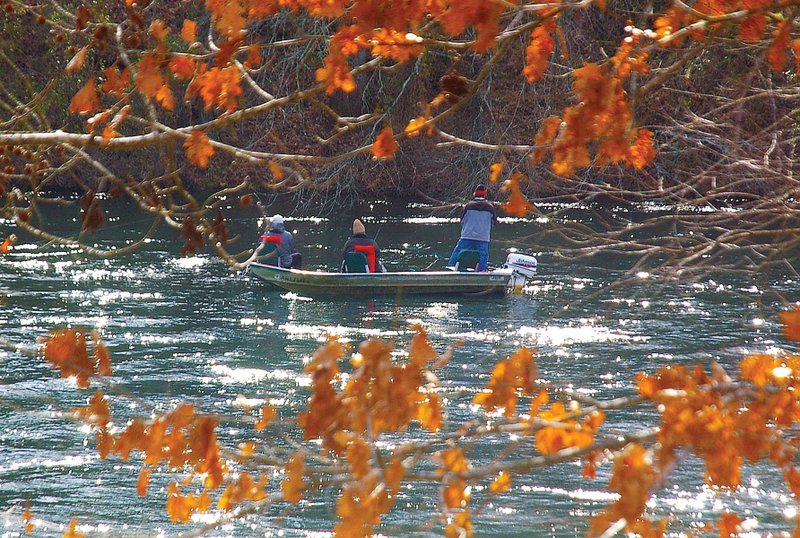My friend Jim and I had headed out that morning in hopes of catching a mess of bluegills, redears and other sunfish on Lake Ouachita near Hot Springs. It was a gorgeous bluebird day in late November, but despite enjoying the beauty of the lingering fall colors, we didn’t get a nibble during three hours of fishing. We decided a change of plans was in order.
We trailered our johnboat and drove a few miles to a put-in on the upper Ouachita River near Pencil Bluff. The lake’s flat, calm water was replaced with current, pools and riffles. Within minutes of beginning our float trip, our fishing luck changed as well.
Jim had put a live cricket on a hook and cast his bobber rig upstream. I watched as the float slipped past a rocky ledge and was pleased when I saw it shoot out of sight. Jim set his hook with an upward snap of the wrist and, seconds later, swung a nice bluegill over the transom.
I tied on a little crawfish-imitation crankbait, knowing it was an irresistible enticement for the rock bass that also called the river home. And after just three retrieves, I found a school of these feisty panfish actively feeding around a big boulder. I caught five in just a few minutes, and during the same interval, Jim landed another bluegill, a big green sunfish and four colorful longears. A day that had started with very little fishing action on the lake had turned into fish-a-minute fun on the stream above the impoundment.
Fall fishing for panfish is often like that in Arkansas. Autumn brings cooler water temperatures, and as fall turnover begins, panfish in lakes and ponds scatter, with concentrations difficult to pinpoint. Some are shallow, others are deep, and anglers must keep moving from one fishing spot to another in order to catch numbers of fish.
Fishing streams eliminates these problems. These flowing environments aren’t subject to the vagaries of turnover, so panfish can be found in familiar haunts.
The word “stream” can describe practically any body of flowing water, from a tiny creek to a river the size of the Mississippi. Here, we’ll confine our discussion to lesser flowages — streams small enough that you’d have no trouble tossing a pebble from one side to the other.
One beauty of these little gems is their usually convenient location. Small streams are found throughout Arkansas, sometimes several to the mile, and each may be home to several species of panfish, including rock bass, bluegills, crappie, longears, green sunfish, spotted sunfish and others. All these waters have something special to offer the adventurous angler.
Fishing for small-stream panfish is like hunting with a rod. Many creatures would eagerly devour them, so panfish tend to be a nervous and wary lot, ready to streak for cover at the slightest intrusion. The silhouette of an angler standing upright will put panfish under rocks, brush piles and cut banks in short order. So like a hunter, you must slip up on the prey unannounced and do your work with extreme stealth.
Any decent cover in a foot or more of water is a potential panfish hideout. Cast upstream or quarter upstream to fallen trees, boulders, brush piles and ledges adjacent to deep water; along the edges of coontail, willow shoots and other vegetation; under overhangs, root wads and logs along the banks; and any place where the water drops into a pool or run. The best of these spots will be in or near long, deep pools, so when you encounter a big hole or a long stretch of deeper water, work it methodically. Drop successive casts about a foot apart, covering a variety of depths until fish are found.
One technique that elicits smashing strikes is to cast up on the rocks or the bank, and jump the bait or lure into the water. Sunfish get a bit crazy when a popping bug or cricket behaves in this manner, or when a tiny spinner leaps from the bank and starts swimming away.
Any bait or lure you use elsewhere will work here as well, but the best bait might be right under your feet. Small crayfish, nymphs, scuds, leeches and insect larvae can often be collected by carefully rolling over rocks in the stream. Worms get lots of attention during or after a rain and can sometimes be found by kicking through leaf litter along the shore. Impaled on a small hook and drifted through a deep hole, any of these baits can entice a hefty bluegill or other panfish when your pet artificials aren’t paying off.
When stream fishing, remember these additional guidelines that will lead you to bigger catches:
• Cast upstream whenever possible, allowing your bait or lure to ride with the current in a natural manner.
• When walking the shore, always fish from the shallow side, entering the water only when necessary. Should you enter the water, do so below the hole you plan to fish so the moving current will carry your vibrations away from the fish.
• Stay as far back from the bank as cover will allow. Move quietly.
• Use small baits and lures and the lightest line feasible for the type of cover you’re fishing.
Though you can fish most small streams by wading or walking the banks, a canoe or other boat can be much more productive than going afoot. You’ll cover more territory and be able to fish locations inaccessible by wading. Belly boats, or float tubes, are useful for covering short stretches. And for a special taste of panfishing fun, try an overnight campout/fishing expedition. Pan-fried bream and crappie never smell or taste better than they do when cooked over a streamside campfire.
Remember, catching panfish is a big part of stream fishing, but catching a limit of memories is the bigger part. Share the joys with your family and friends. You’ll be glad you did.
